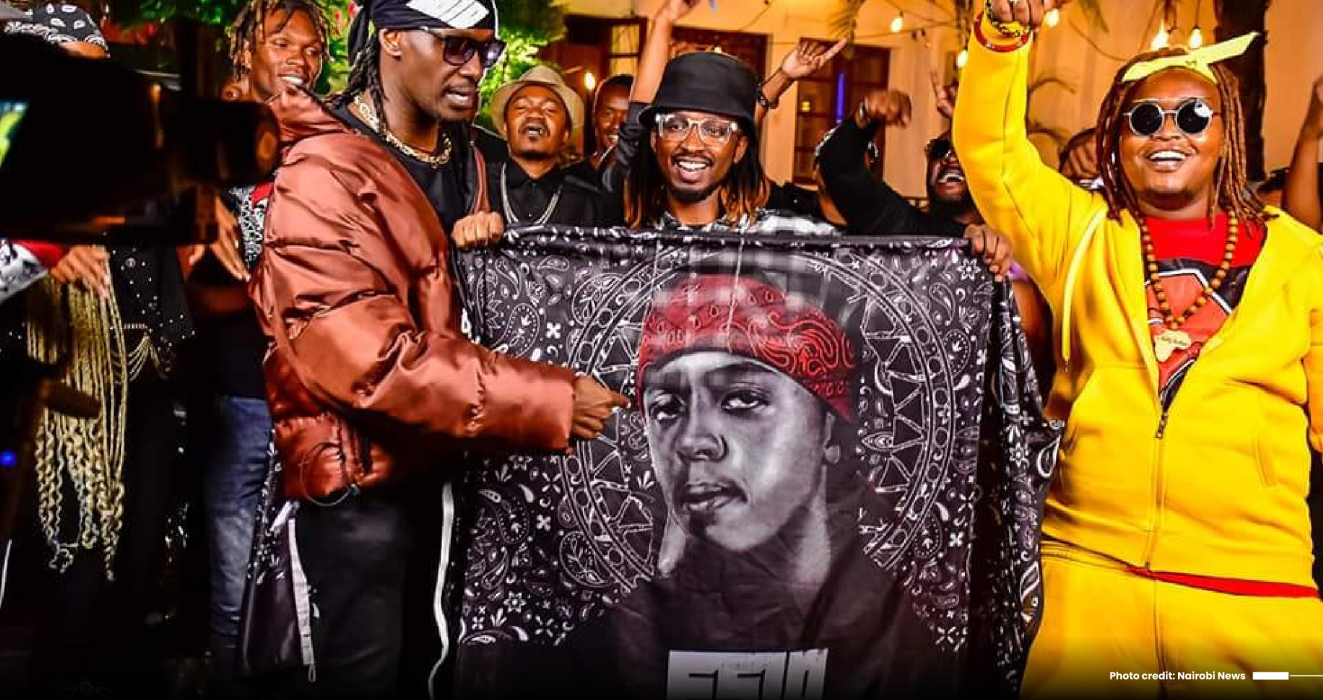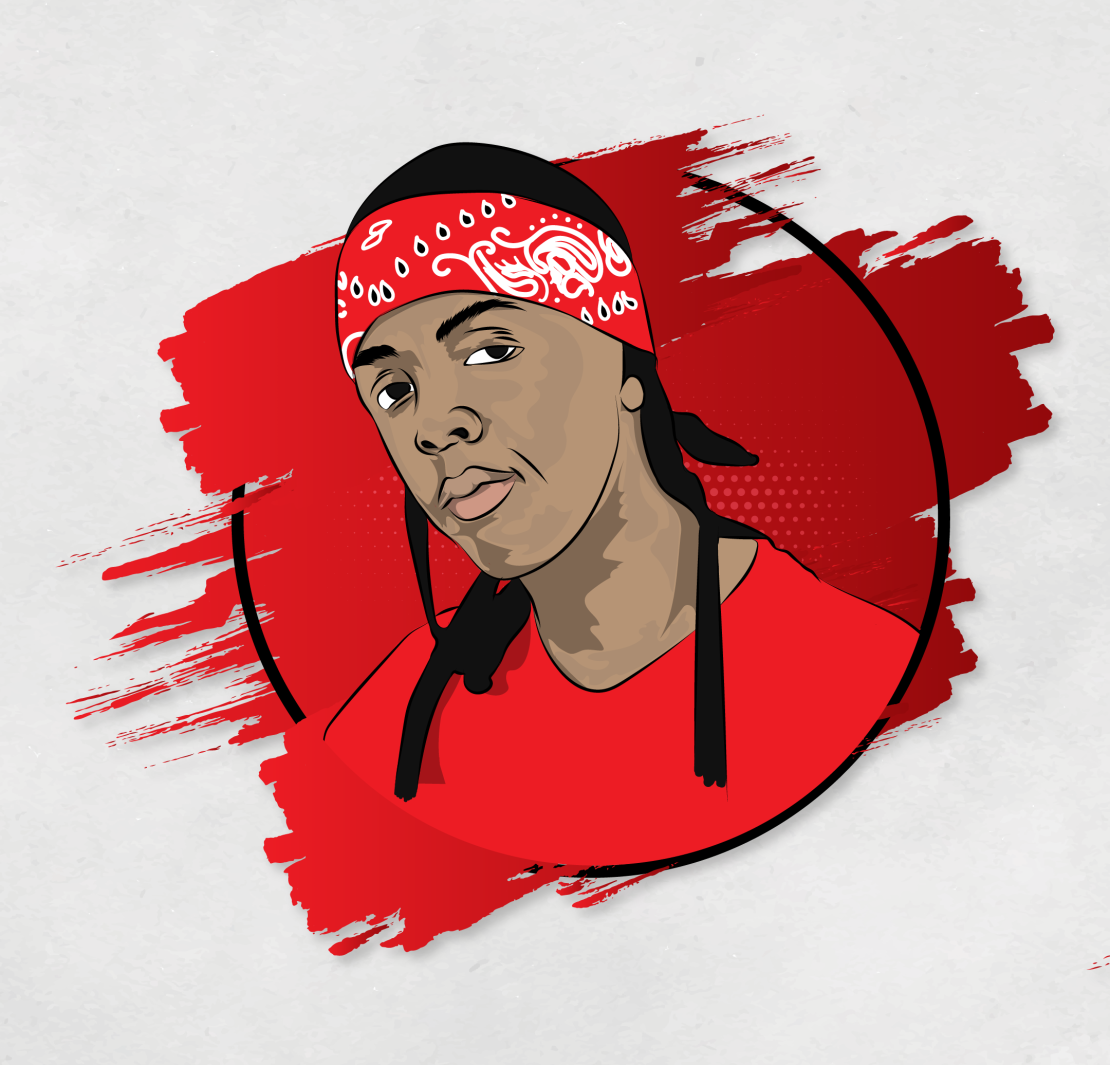For a brief moment in 2003, my favourite musician, E-Sir, would come back from the dead. It had been a few months since the news had reached us through the smuggled Palito Scan radio sets we hid from the pervading eyes of the teachers on duty. The news had broken me because I had loved E-Sir and his music, from the time I listened to Nimefika Jo through my friend Kash’s new Aiwa Sound System that his father had brought from Dubai. E-Sir’s death was my first parasocial loss, the grief new and raw, familiar only in that it resembled my cousin Njeri’s when Tupac Shakur died. But now, here we were tuned in to the countdown on Saturday morning, listening to a new song by Nameless and E-Sir, his voice coming from the speaker full of life, months after E-Sir’s death.
E-Sir’s life had been, for me, a promise of the future. It was an affirmation of two things: that your writing could mean something to the world regardless of how old you were, and that the music industry was capacious enough to create room for anyone – even me. I wrote my little rhymes as I imagined collaborations between E-Sir and Nonini, E-Sir and Necessary Noize, and eventually, E-Sir and 4T1 (my pen name when I was rapping in high school). His presence and music came like a wave, all at once. And then he was gone, the only promise left being that of his memory, that through his music we would never forget him. Issa Mmari Wanjiku, born on 20 May 1981 and died on 16 March 2003 was once again, at least to me, alive.
Maisha starts with a snippet of E-Sir’s voice, a fragment of a conversation in the studio, or something recorded specifically for this song. This is expected. A few of his songs start in the same way: his voice introduces the featured artist, or the theme of the song, or prepares the listener for what is about to come. And then Nameless starts. The anticipation builds. The first verse comes, the second verse goes. This is radio so I can’t skip ahead. I have listened to the chorus twice. Fine, Nameless, I won’t mess with your maisha. When the third verse starts I grow wary of this collaboration. Is this the early days of clickbait? My hands are sweaty around the shiny plastic casing of the radio set I’m holding, and I’m doing my best to keep my fingers still, not to press the scan or reset buttons. Nameless continues, and then, finally, he says, “Hey yo E-Sir, pass the courvoisier”. After a minute and fifty seconds, which feels like an eternity, E-Sir responds, “Ati nini?” His voice sounds exactly the same, like if I skived off school and took a matatu to Nairobi and another to South B, I would find him at the Ogopa Deejays studio recording the next song. When his verse starts, time, and everything around me stops. And for the briefest of moments, I understand immortality.
*
Our story of E-Sir, starts in South C. E-Sir’s story, however, starts in California Estate. Born the third child in a family of five children to Damaris Wangui and Amin Mmari, E-Sir grew up in California Estate, before moving to Juja, and then Mlango Kubwa, and finally South C where we would know him as South C’s finest. It was in South C that he met friend and fellow rapper Big Pin who had just moved to the estate after being shot in a robbery at their former home in Ngumo.
Big Pin and E-Sir hit it off quickly, both drawn to each other’s love for rap and writing. After sitting his O-level exams at Brookhouse International School, E-Sir spent most of his free time writing, and rapping. One day, while in a car with his friends on the way to the Blackrock Rugby Festival, Woah! By Black Rob came on the radio. Incidentally, E-sir had written something over the beat and was excited at the opportunity to perform for his friends. Always a skilled entertainer, he knew the importance of audience participation. So he made a request: “Nikimaliza mstari mseme jo!”
“Kuna kuna kijana mmoja kutoka South C…”
“Jo!”
E-Sir’s relationship with Big Pin had grown from merely friends to writing partners. When E-Sir finished his part, Big Pin started, asking the audience to punctuate his sentences with “yawa!” Thus Nimefika Jo was born and it was unanimously decided that they should record it.
The following months saw the pair looking for a studio, trying and failing to find someone who would record their music. After a while, they had a break and a producer at Brick House Records said that he would record an album for them for about ten thousand shillings. Inspired by Method Man and Redman, the duo recorded four songs at the studio. And then one day, arriving for a studio session, they found the studio closed and the producer nowhere to be found. E-Sir and Big Pin were left with a DAT tape with only one song on it, and no way of playing it. Months passed and life went on and on the radio, Ogopa Deejays were now the most popular recording studio. The duo soon learned that the studio was in South B, minutes away from where they lived and they decided to check it out. Lucas Bikedo was immediately impressed by Nimefika Jo and agreed to record their songs.
Within a few months, E-Sir had recorded enough songs to make an album. Nameless’ album was scheduled to be released next, but his writing speed could not match the new artist’s and so it was agreed that the studio works on E-Sir’s album first. Nimefika, the fourteen track album was released two months after E-Sir’s death, and contained some of the most popular songs of the time that served as party anthems, as well as timeless classics. Nimefika, released twenty years ago, is still as good now as it was then.
The Comedies
In his CTA interview, Big Pin says that when E-Sir was working on his album, a period he refers to as ‘when E-Sir was on overdrive’, they spent the money they had buying albums and listening to them to make sure that the projects they released would be ‘proper’. An important part of albums for them was the skits.
The skits on Nimefika sound like most kenyan skits in the early 2000s which is to say, they sound like high school drama festival skits in their exaggerated characterisation and dialogue. In the first one, the intro to the album, Jobless Corner 1, the stage is set. A group of young men are seated at the estate ‘base’, held in a moment of togetherness as the sound of the world moving surrounds them. Cars drive by, people go on about their business, problems exist somewhere in the world, but not here. There are the main characters: Bablas, Bouncer, Krucial. There is alcohol and miraa, and something else announced to make things better. The reveal: a stereo. They deliberate on what to listen to as a figure is spotted approaching them. They recognise him as E-Sir. The artist approaches, greets them, chats for a bit, and leaves. “Is he a superstar or not” is the topic of discussion. The group agrees to answer the question by listening to the music.
In Jobless Corner 2, they take a break from the album. The question that was raised in the first skit is answered. “Yenyewe amesimama.” It is agreed. E-Sir is the superstar he thinks he is. It is apparent now that we are experiencing the moment together. A sort of fourth wall situation where I, the listener, am part of the crew. Someone has taken someone’s gomba. Is it Bablas? Krucial? Both of them seem capable of the crime. Look at them, Bablas speaks a lot, Krucial not so much. A slight argument arises. Again, any disagreement is solved by the music. Bablas presses play.
In the final skit, Kiamaiko, a character for whom the skit is named, joins the crew. The album is now over and they are sharing notes. We know Kiamaiko and we don’t like him. He is always asking for our gomba and when we say no he insists that we buy him a soda. He is always asking for something. Now he has joined us and he is killing the vibe with his high pitched voice singing the songs, we have come to love, offkey. Kiamaiko is the buffoon in our play and everyone hates him and with reason. Bablas suggests a solution: “tafadhali rewind”.
The skits are a caricature of life in the estates, snapshots of lives lived or imagined. E-Sir included the skits in his album because it was dope, and all serious albums have skits in them. But he also included them to make us see ourselves, each in our own mtaa, with our own Bablas and Kiamaiko, our own heroes and villains, our own stories. And through these skits, a mirror held in our direction, what we saw made us laugh, and when we couldn’t laugh, we listened to the music.
The Histories
In the early 2000s, Ogopa Deejays was arguably the biggest most influential recording label in Kenya. Others like Tedd Josiah’s Blu Zebra had produced popular hits such as Ndarlin’ P’s 4-in-One, Gidi Gidi Maji Maji’s Ting Badi Malo and Unbwogable, Suzanne Owiyo’s Kisumu 100, and Necessary Noize’s Clang Clang. Across the city, Calif Records were making a name for themselves with the likes of Jua Cali’s Ruka, Nonini’s, Manzi wa Nairobi, and Ratatat’s self-titled track. Ogopa Deejays had the likes of Chameleone, Redsan, Amani, Nameless, Mr. Googz and Vinnie Banton, Deux Vultures, Kleptomaniax, and E-Sir ruling the airwaves. Shows such as KBC’s Mizizi, Nation TV’s Warehouse and later on The Beat meant that audiences could enjoy their favourite songs on radio and TV. This was a wonderful time for Kenyan music.

For E-Sir, this was an important period, a time where he was able to record all of his songs, perform at a myriad of shows, win awards, and garner the love and admiration of audiences across East Africa. One of his first collaborations with Mr. Lenny captures the spirit of the moment. In the fourth verse of the song, E-Sir says:
“Huu mwaka
Ka moto, tutawaka
Na wote walioongea taka taka
Bila shaka, wata (Shh!)
Huu mwaka.”
And then in hook of the next song, Bamba with Big Pin and K-Rupt, he says:
“Huu mwaka
Ka-kilo za gomba, tutabamba
E-Sir, Big Pin na K-Rupt
Twahanda hizi tracki, zabamba.”
‘Huu mwaka’ for E-Sir, was an affirmation, a manifesting, if you will, of what he envisioned and desired. Huu mwaka. This year. And in that year, E-Sir would win 4 Kisima Awards: Song of the Year for Boomba Train, Best Male Artist, Best Hip Hop Artist, and Album of the Year for Nimefika.
Beyond Ogopa’s popularity, E-Sir also demonstrates the (party) spirit that had taken over Kenyan youth who were celebrating the end of a 24 year long dictatorship. Unlike songs like Gidi Gidi Maji Maji’s Unbwogable which were co-opted for political purposes, E-Sir’s music was not. Still, his music was political. It articulated a people’s enduring spirit, the spirit of we are here and we will have a good time, even as the world goes to hell. Kamata, Bamba, Saree, Boomba Train, and Leo ni Leo, are invitations to let loose, to dance, to imagine and create ways of living in spite of…. All this while painting a picture of Nairobi with impressive detail, including the anxieties and desires of the time, as well as maps to points of pleasure:
“Mpaka wapi leo, bro?
Baada ya Kengeles, tutamalizia Carnivore…”
“…Kama uko ndani ya club
Iwe Mamba, Carni, Basement au club yoyote
Mwambie DJ akupe scratch mbili…”
One of my favourite quotes that really speaks to the spirit and music of the time is Big Pin’s line from Bamba. In the most ‘only the now matters and time means nothing’ way, he says, “everything that we did is about to be done.”
The Tragedies
“Nani mwingine mwamjua Kenya nzima kama mimi?”
E-Sir knew who he was. He said it in his music and we believed him. This clarity is what made his death so hard to deal with, because we knew exactly what, and who, we had lost. It is one thing to listen to a rapper talk big of himself. In fact, we are used to it. Almost all rappers do it. But E-Sir, maybe because of the time he joined the industry, and the state of Kenyan music at the time, when he says, “kama mvua nanyesha mahewa nikileta / wako wengi lakini it’s obvious I’m better.” The bar is ‘fire’ because it is true.
There is a lie I have told myself for twenty years. I call it a lie because I do not want to know whether it is true or not because it might change the way I see things. The lie: E-Sir’s least popular songs were his most cherished because in them he was his true self, and they speak the most truth about who he was and how he lived. My lie is further defended by the fact that he started writing these songs earlier on when he was still writing rhymes and poems in his notebook, before he joined Ogopa Deejays and focused on producing hits. These were special songs, songs written in that space between obscurity and fame, songs he cared for deeply, and this is seen in a story shared by friend and collaborator Talia Oyando.
In a tribute show on Citizen TV’s 10 Over 10, Talia recounts the story of how Hamnitishi was recorded. “He wrote the song, and during that week he kept saying we have to go to the studio, we have to do this song.” E-Sir had been working on the song almost obsessively, tweaking things, rewriting others. When it was done, he went to Talia’s house, who was going to sing the hook, and found that she was sick with malaria. She said that she could not make it to the studio and E-Sir told her that if he did not record that song on that day it would not be recorded. “Either we go record this song, ama tuseme tu Hamnitishi will never happen.” E-Sir insisted and offered to carry Talia on his back from Nairobi West to South B, stopping on the way to buy her a tonic water with the 15 shillings they had between them. “He carried me all the way to the studio, and we recorded the song, and it was just magic.”
I wonder, if this is the urgency with which he recorded all of his songs, does it mean that he knew he only had a short time left? If so, why then does he, in Hamnitishi, say, “bila spare tyre / nasafiri kwenye barabara ya maisha bila kutaka / saa yoyote naweza kupata puncture / kwa hivyo naendesha gari yangu pole pole sana…” or why does he end the hook in Moss Moss, which translates to slowly, with, “haraka haraka haina baraka”? Why the conflicting ideas?
All we are left with is speculation. If E-Sir lived a slow paced life maybe he would have chosen to do a show on another day instead of the 15th of March. Maybe he would not have recorded the songs that made him so popular. Maybe he would still be alive.
But also maybe what E-Sir meant with the image of slowness was presence. To live a full life while enjoying every moment. To be unafraid in the face of life, certain of the uncertainty of everything. To keep track and bear witness to the movement of time as fast or slow as it is, and to be thankful for life, and those that brought you there. Through Moss Moss, Lyrical Tongue Twister, Nimefika Jo, and Hamnitishi, E-Sir told us who he was, and why he did things the way he did. When I picture a young man carrying a sick Talia past the old mosque in South C towards the bridge, heading to South B, I understand why the song had to be recorded now.
Keeping E-Sir Alive
On 16th March, on the way from a show at Club Dimples in Nakuru, E-Sir would die after the car they were travelling in lost control and rolled. He was 21 years old.
I have listened to as many interviews, videos, and talks as there are on the internet, and found that more people know about his death than his life. Artists and friends recount the day he died with details, at times it feels wrong to listen to this information over and over again. The message from these videos is clear. As well intentioned as they are, as celebratory and honouring as they claim to be, in all of them, E-Sir is dead.

But E-Sir lives on. In our memories, our attempts to honour him, and the music he left us, he is alive. To borrow Keguro’s words from his meditation on John Keene’s memory work, perhaps what I mean in writing all this is that E-Sir’s music “is generous in what it observes and records and remembers. It describes how we make lives with others. The textures and sounds of the spaces we borrow and occupy.”
And this generosity will never die.

